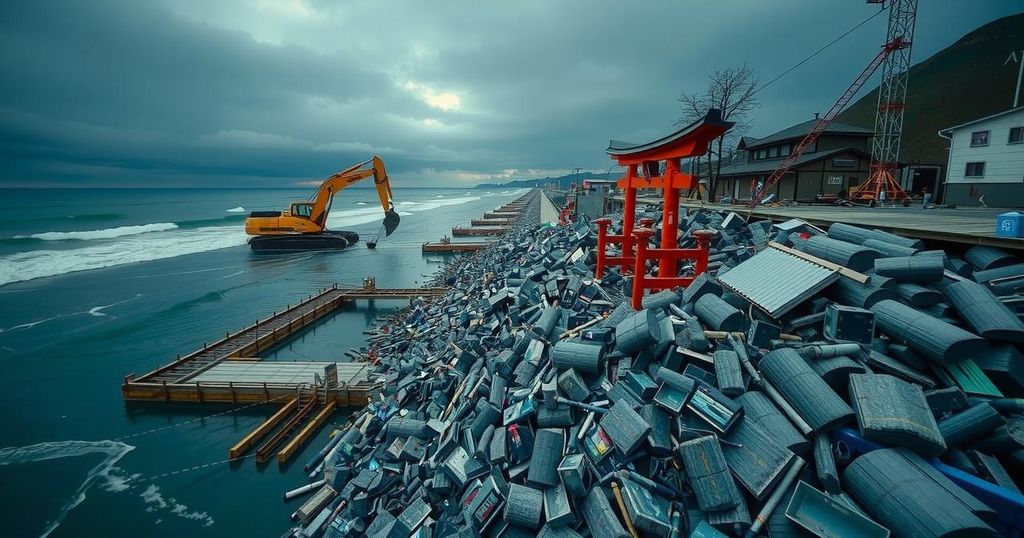Japan’s Earthquake and Tsunami of 2011: A Comprehensive Overview of Relief and Recovery Efforts
The 2011 earthquake and tsunami in Japan resulted in major destruction and loss of life. The Japanese government and international organizations rapidly mobilized for relief. Initial rescue efforts encountered challenges, with widespread displacement occurring. Recovery included infrastructure restoration, economic support, and the establishment of a Reconstruction Agency. Significant progress was reported years later, though many continued to face displacement due to the Fukushima crisis.
In the aftermath of the devastating earthquake and tsunami that struck Japan on March 11, 2011, the government, led by Prime Minister Kan Naoto, rapidly mobilized an extensive relief and recovery operation. An emergency command center was established in Tokyo, and approximately 100,000 personnel from the Japanese Self-Defense Force were summoned to the affected areas. Additionally, assistance was sought from U.S. military forces stationed in Japan, leading to the deployment of a U.S. Navy aircraft carrier to aid in rescue efforts. In response to the disaster, numerous countries including Australia, China, India, New Zealand, South Korea, and the United States dispatched search-and-rescue teams, while various international humanitarian organizations, such as the Red Cross and Red Crescent, provided financial and material contributions. Moreover, both domestic and international private organizations established relief funds to support victims and facilitate recovery initiatives. The initial phases of rescue operations faced significant challenges due to the destruction that rendered many roads impassable and adverse weather conditions that hampered airlifted supplies. Although some survivors were rescued within days of the disaster, the majority of efforts were dedicated to recovering deceased individuals, many of whom were found along the coast having been swept out to sea. Hundreds of thousands were displaced, seeking refuge in temporary shelters with limited resources, while tens of thousands remained trapped in isolated regions. Over time, the number of evacuees began to decline as individuals sought shelter in various arrangements, including prefabricated housing units and accommodations in hotels or public residences. Following the catastrophe, transportation infrastructures in northern Honshu were progressively restored, with major highways and train services resuming operations. However, the nuclear crisis at the Fukushima plant continued to affect the region’s power supply, leading to temporary outages and blackouts. The economic ramifications were profound as businesses in critical sectors such as technology and manufacturing faced unprecedented losses, yet by late summer 2011, industrial output was recovering, returning to pre-disaster levels by early 2012. In the legislative response to the disaster, the Kan and Noda administrations successfully advocated for three supplemental budgets focused on disaster relief, culminating in a sizable reconstruction budget approved in November 2011. The establishment of a Reconstruction Agency in February 2012 marked a pivotal step in coordinating recovery efforts over a projected ten-year timeline. By early 2015, the agency reported substantial progress, including the removal of nearly all disaster debris and the initiation of several infrastructure projects designed to promote resilience in vulnerable coastal areas.
The 2011 Japan earthquake and tsunami, known as the Great East Japan Earthquake, resulted in immense loss of life and widespread destruction. Occurring on March 11, the disaster triggered a powerful tsunami that devastated coastal towns and led to a nuclear crisis at the Fukushima Daiichi Nuclear Power Plant. This catastrophic event prompted an unprecedented emergency response both within Japan and from the international community, showcasing the resilience and solidarity of the nation amidst one of its most challenging times. The eventual recovery process necessitated extensive governmental coordination, rebuilding of infrastructure, and long-term economic strategies to restore not only physical structures but also the affected communities’ livelihoods.
The 2011 earthquake and tsunami in Japan prompted swift and wide-ranging relief and recovery efforts, illustrating the nation’s resilience in responding to a catastrophic crisis. Initial rescue operations faced formidable obstacles; however, collaborative international assistance and a structured governmental response facilitated a gradual recovery. Although many people are still displaced years later due to the Fukushima nuclear incident, significant progress has been achieved in restoring infrastructure and reviving economic activities. Japan’s response to this disaster stands as a testament to effective crisis management and community unity.
Original Source: www.britannica.com




Post Comment